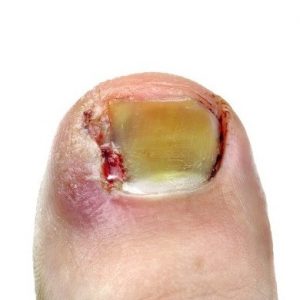Ingrown Toenails
 An ingrown toenail is medically diagnosed as onychocryptosis, and it is a highly common problem that, in most cases, affects the large toenail. A typical toenail is supposed to grow in a vertical and or outward position that goes towards the edge of the toe.
An ingrown toenail is medically diagnosed as onychocryptosis, and it is a highly common problem that, in most cases, affects the large toenail. A typical toenail is supposed to grow in a vertical and or outward position that goes towards the edge of the toe.
The main cause for an ingrown toenail is the result of nail growing sideways towards or into the skin of the toe. As the toenail continues to grow abnormally, it will begin pushing all the skin surrounding it, which then results in a lot of pain and discomfort to the owner of the toe.
Symptoms of an Ingrown Toenail
Some of the most commonly reported symptoms for ingrown toenails are painful and sore nails that grow into the skin fold. The surrounding affected skin can have several different degrees of swelling, redness, and in cases where its infected, there can also be clear or yellowish colored drainage.
In most cases you can treat an ingrown toenail on your own without the need for a medical professional. However, prolonged cases or other complicated factors (such as being a diabetic) could result in you needing to see a physician or podiatrist right away. Continue reading
The pain and discomfort you feel from an ingrown toenail is certainly no fun at all. Some might think this sort of thing only happens to athletes but, truth be told, it can happen to anyone. Many people wonder what the causes are for ingrown toenails, ways to prevent them from happening, and even how to tell if you’re suffering from one. Below is a brief rundown of all of the above.
What Causes Ingrown Toenails?
There are a few causes of ingrown toenails, and generally a torn nail will not result in an ingrown toenail. Most of the common causes include: improper clipping of your nails meaning they are cut too short or not cut straight across, wearing shoes that bunch your toes together, naturally curved nail growth, and/or an injury to your toenail.
Who is Most Likely to Get an Ingrown Toenail?
While ingrown toenails can happen to just about anyone there are some people that are more likely to be affected. They include: children who do athletics, people who wear improper shoes, repeated injuries to the feet, congenital foot abnormalities, poor feet hygiene, obesity, diabetes, naturally short nails, arthritis, and excessive feet sweating. Continue reading






